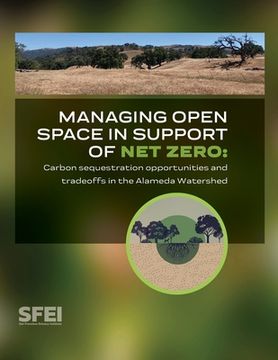Managing open space in support of net zero: carbon sequestration opportunities and tradeoffs in the Alameda Watershed (in English)
Synopsis "Managing open space in support of net zero: carbon sequestration opportunities and tradeoffs in the Alameda Watershed (in English)"
Encompassing 39,000 acres in the East Bay, the Alameda Watershed is one of the largest public land holdings in the San Francisco Bay Area. The site of several water supply reservoirs, the watershed is managed by the San Francisco Public Utilities Commission (SFPUC) for both water resources protection as well as biodiversity conservation, fire risk reduction, and other goals. The landscape is characteristic of the region, with rugged topography and vegetation dominated by grasslands, shrublands, and oak woodland habitats, along with riparian forests and wetlands. Carbon sequestration in the watershed's ecosystems has received increasing attention as a potential nature-based strategy toward San Francisco's net zero GHG emissions goal. To support SFPUC managers in making informed carbon management decisions, this carbon assessment for the Alameda Watershed offers scientific guidance on the watershed's current and potential performance as a natural climate solution. Two main objectives framed this analysis: to quantify existing carbon stocks in the watershed, and to evaluate opportunities to enhance carbon sequestration in the watershed's vegetation and soil.This report provides basic information on the state of the watershed's carbon stocks and the science around carbon management so that SFPUC managers may make informed management decisions. This report consists of five chapters. Chapter 1 (this chapter) introduces the topic of carbon management on natural and working lands. This chapter includes a very brief primer on carbon cycle principles and terminology used throughout this report.Chapter 2 offers background for the reader on how the ecology and management history of the Alameda Watershed influence its carbon storage. Current carbon stocks, rates of CO2 uptake and greenhouse gas emissions, and the potential for future sequestration all depend on characteristics of the ecosystem-its climate, vegetation, and soils-and the history of human activities on the landscape.Chapter 3 presents watershed-wide estimates of current carbon storage. This chapter describes the modeling and data synthesis methods used to map carbon storage in vegetation and soils, and presents the findings with maps, graphs, and tables. This analysis provides context for evaluating future carbon management opportunities and quantifies the value of carbon storage that is currently provided by open space conservation in the watershed. Chapter 4 describes a set of potential strategies for managing carbon in the watershed. For each management approach, this chapter provides an estimate of its carbon sequestration potential and presents key considerations for its suitability in the watershed. Such considerations include potential co-benefits for other ecological functions, potential tradeoffs with other management goals, and uncertainty and risk in its long-term capacity to sequester and store carbon. Synthesizing findings from the previous chapters, Chapter 5 offers broad recommendations related to carbon management. This chapter does not prescribe specific actions, but rather highlights conclusions, discusses their implications, and identifies key questions and areas for future research.

